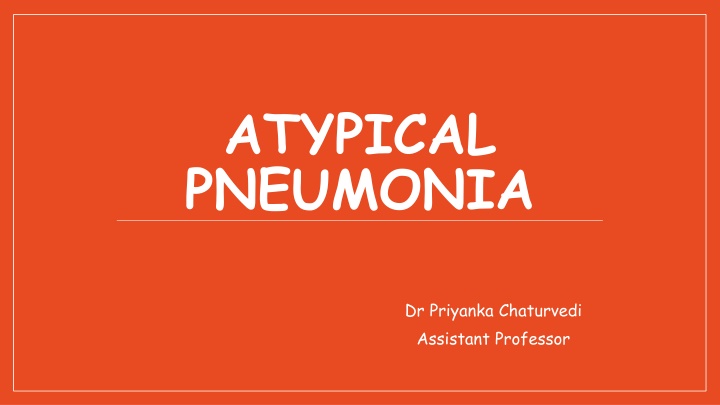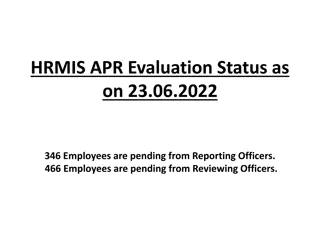
Understanding Mycoplasma Infections and Pathogenesis
Explore the world of atypical pneumonia caused by Mycoplasma, a unique microbe lacking a cell wall but possessing a triple-layered cell membrane. Learn about its history, classification, and pathogenicity in causing pneumonia and other infections. Dive into the details of Mycoplasma's general properties, reproduction methods, and the human pathogenic species it comprises. Uncover the intriguing characteristics of this tiny yet impactful organism.
Download Presentation

Please find below an Image/Link to download the presentation.
The content on the website is provided AS IS for your information and personal use only. It may not be sold, licensed, or shared on other websites without obtaining consent from the author. If you encounter any issues during the download, it is possible that the publisher has removed the file from their server.
You are allowed to download the files provided on this website for personal or commercial use, subject to the condition that they are used lawfully. All files are the property of their respective owners.
The content on the website is provided AS IS for your information and personal use only. It may not be sold, licensed, or shared on other websites without obtaining consent from the author.
E N D
Presentation Transcript
ATYPICAL PNEUMONIA Dr Priyanka Chaturvedi Assistant Professor
INTRODUCTION Infection occurring in the interstitial space of lungs. Cough is characteristically non-productive. Respiratory viruses - influenza viruses, corona viruses, respiratory syncytial virus, adenoviruses Epstein Barr virus and
MYCOPLASMA Smallest environment and self-replicating on artificial culture media microbes capable of free-living in the Very small (150 350 nm), filterable Can grow on artificial cell-free culture media
General Properties of Mycoplasma Lack cell wall Have a TRIPLE LAYERED CELL MEMBRANE containing sterol - Completely resistant to antibiotics acting on cell wall such as - lactam Pleomorphic - coccoid, bacillary or filamentous Poorly Gram-negative
General Properties Reproduce by binary fission and budding Nonmotile. However, gliding motility is seen in some species due to their specialized tip structures
History The name Mycoplasma - derived from Myco meaning fungus-like, forming branching filaments and plasma, denoting their plasticity of shape Previously (PPLO) and Eaton s agent (after the Monroe Eaton, who first isolated). called as pleuropneumonia-like organisms
Classification Family Mycoplasmataceae comprises of two genera (1) Mycoplasma and (2) Ureaplasma
Classification Human pathogenic species are: Mycoplasma pneumoniae causing pneumonia Others cause genital tract infections: Mycoplasma hominis Mycoplasma genitalium Ureaplasma urealyticum Ureaplasma parvum.
Pathogenesis Attachment of M. pneumoniae to the respiratory mucosa (mediated by its membrane bound adhesion proteins) Induces injury to host respiratory tissue.
Epidemiology Transmission: Respiratory droplets Facilitating factors: close contacts as in families, military bases, boarding schools, and summer camps Incubation period :2 4 weeks.
Clinical Manifestations - Upper Respiratory Tract Infections (URTI) Pharyngitis, tracheobronchitis or rarely otitis media Acute in onset and 20 times more common than pneumonia
Clinical Manifestations - Pneumonia Atypical community acquired interstitial pneumonia Eaton agent pneumonia Primary atypical pneumonia Walking pneumonia
Clinical Manifestations - Pneumonia Gradual onset Wheeze or rales Dry cough Peri-bronchial pneumonia with thickened bronchial markings Streaks X-ray. of interstitial infiltration on chest
Clinical Manifestations - Extrapulmonary Manifestations Occur as a result of active Mycoplasma infection (e.g. septic arthritis) Postinfectious autoimmune phenomenon (e.g. Guillain Barre syndrome). Neurologic: Meningoencephalitis, encephalitis, Guillain- Barre syndrome and aseptic meningitis
Clinical Manifestations - Extrapulmonary Manifestations Dermatologic: multiforme major (Stevens Johnson syndrome) Skin rashes including erythema Cardiac: Myocarditis, pericarditis Rheumatologic: Reactive arthritis Hematologic: Anemia and hypercoagulopathy
Laboratory diagnosis of Mycoplasma pneumonia Specimen: bronchial brushing, BAL and lung biopsies Throat swabs, nasopharyngeal aspirates
Laboratory diagnosis of Mycoplasma pneumonia Culture: Solid medium containing PPLO agar: Produces fried egg appearance colonies Liquid turbidity and a color change medium containing PPLO broth: Produces
Laboratory diagnosis of Mycoplasma pneumonia Mycoplasma colonies (typical fried egg appearance)
Laboratory diagnosis of Mycoplasma pneumonia Identification: By biochemical tests or by automated identification systems such as MALDI-TOF Antigenic detection: By Direct IF, ELISA
Laboratory diagnosis of Mycoplasma pneumonia Antibody detection in serum: Specific: Indirect-IF, latex agglutination assays and ELISA using protein P1 antigens Molecular methods: Detects 16S rRNA and P1adhesin gene.
Treatment of Mycoplasma pneumonia Macrolides - drug of choice (oral azithromycin, 500 mg on day 1, then 250 mg on days 2 to 5) Alternative drugs are as follows: Doxycycline Respiratory moxifloxacin and gemifloxacin (not ciprofloxacin). fluoroquinolones - levofloxacin,
CHLAMYDIAE PNEUMONIA There are three Chlamydia species C. pneumoniae C. psittaci C. trachomatis All capable of causing atypical (interstitial) pneumonia.
Chlamydophila pneumoniae Exclusive human pathogen, causes various manifestations: Transmission - person to person by inhalational route Atypical pneumonia -10% pneumonia Upper respiratory tract - pharyngitis and sinusitis Asthma and COPD Treatment: Tetracycline or erythromycin (500 mg four times a day) for 10 14 days. community-acquired
Chlamydia trachomatis (Infant Pneumonia) C. trachomatis serotypes D to K - cause infant pneumonia. Interstitial pneumonia that develops within 3 weeks to 3 months of birth. Infection spreads from conjunctiva to pharynx via the nasolacrimal duct. Infection via the eustachian tube - cause otitis media Treatment: Erythromycin - orally at a dosage of 50 mg/kg per day in four divided doses, for 2 weeks.
LEGIONELLOSIS Caused by Legionella pneumophila Fastidious, pleomorphic Gram-negative, short rods, associated with interstitial pneumonia, known as Legionnaires disease.
History Legionella was first recognized in 1976 when an outbreak of pneumonia took place at a Philadelphia hotel during an American Legion convention.
Epidemiology Reservoir: Inhabits on aquatic bodies which could be either: Natural water sources - rivers Artificial aquatic sources - air conditioners, water coolers, shower head.
Epidemiology Transmission: Aspiration colonization or directly via drinking of contaminated water (predominant mode):oropharyngeal Aerosols nebulizers, and humidifiers from contaminated air conditioners, Direct instillation into the lungs during respiratory tract manipulations
Pathogenesis Following entry, legionellae reach the lungs Engulfed by alveolar macrophages by a mechanism - coiling phagocytosis. They invade and grow within the alveolar macrophages by inhibiting phagosome-lysosome fusion.
Clinical Manifestations Pontiac Fever Acute, flu-like illness - malaise, fever, and headache. Incubation period - 24 48 hours. Self-limiting, never develops into pneumonia.
Clinical Manifestations - Legionnaires Disease (Pneumonia) Interstitial atypical pneumonia with incubation period of 2 10 days. Characterized by non-productive cough (with or without blood tinged), dyspnea, chest pain & high fever Chest X-ray - pulmonary infiltrates Leading cause of pneumonia both in the community and hospital settings.
Clinical Manifestations - Extrapulmonary Legionellosis Results from blood-borne dissemination from the lung. Most common extrapulmonary site is heart (myocarditis, pericarditis and prosthetic valve endocarditis) Other pyelonephritis, skin and soft tissue infection. manifestations - sinusitis, peritonitis,
Laboratory Diagnosis Specimens - Bronchoalveolar lavage fluid, bronchial wash and pleural fluid. Direct Microscopy Gram stain - Numerous neutrophils but no organisms (as legionellae are poorly stained or sometimes appear as faint pleomorphic Gram-negative rods or coccobacilli)
Laboratory Diagnosis A B Gram-staining: pleomorphic Gram-negative rods or coccobacilli
Laboratory Diagnosis Direct microscopy: Silver impregnation Giemsa stains Direct immunofluorescence test - more specific but sensitivity is poor than culture
Laboratory Diagnosis Culture: Buffered charcoal, yeast extract (BCYE) agar: Incubated at 37 C in 5% CO2 for 3 5 days. Highly sensitive (80 90%) and specific (100%)
Laboratory Diagnosis Antibody detection: Indirect immunofluorescent antibody test and enzyme immunoassays. Antibodies - appear late after 12 weeks; a single titer of 1:256 gives presumptive evidence of Legionnaires disease
Laboratory Diagnosis Urinary antigen test: Detect L. pneumophila antigens in urine. Advantages: Rapid, cheaper, easy to perform Highly sensitive (70 to 90%), and specific (95 100%) Antigen in urine - detectable shortly after the onset of symptoms and disappears over 10 months
Laboratory Diagnosis Molecular methods: BioFire FilmArray; automated multiplex PCR - its respiratory panel can simultaneously detect 22 pathogens including L. peumophila.
Treatment of Legionnaires disease Macrolides (especially azithromycin) and the respiratory quinolones (e.g. levofloxacin) are now the antibiotics of choice.
Water Surveillance for Legionella Indication: Performed annually or more often for certain high-risk settings - transplant units Procedure: Large volume of water (1-10 L) collected and subjected to membrane filtration, followed by culture on BCYE media.
OTHER BACTERIAL causes of ATYPICAL PNEUMONIA Coxiella burnetii Rickettsial infections Francisella tularensis










